
Brandywine order of battle
Encyclopedia
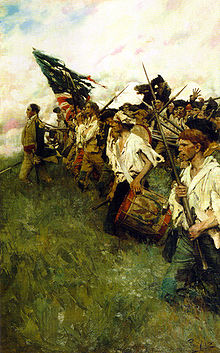
Battle of Brandywine
The Battle of Brandywine, also known as the Battle of the Brandywine or the Battle of Brandywine Creek, was fought between the American army of Major General George Washington and the British-Hessian army of General Sir William Howe on September 11, 1777. The British defeated the Americans and...
on September 11, 1777 saw a colonial American army led by Major General
Major General
Major general or major-general is a military rank used in many countries. It is derived from the older rank of sergeant major general. A major general is a high-ranking officer, normally subordinate to the rank of lieutenant general and senior to the ranks of brigadier and brigadier general...
George Washington
George Washington
George Washington was the dominant military and political leader of the new United States of America from 1775 to 1799. He led the American victory over Great Britain in the American Revolutionary War as commander-in-chief of the Continental Army from 1775 to 1783, and presided over the writing of...
fight a British-Hessian army commanded by General William Howe, 5th Viscount Howe
William Howe, 5th Viscount Howe
William Howe, 5th Viscount Howe, KB, PC was a British army officer who rose to become Commander-in-Chief of British forces during the American War of Independence...
. Washington drew up his troops in a defensive position behind Brandywine Creek. Howe sent Lieutenant General
Lieutenant General
Lieutenant General is a military rank used in many countries. The rank traces its origins to the Middle Ages where the title of Lieutenant General was held by the second in command on the battlefield, who was normally subordinate to a Captain General....
Wilhelm von Knyphausen
Wilhelm von Knyphausen
Wilhelm Reichsfreiherr zu Innhausen und Knyphausen was a general from Hesse-Cassel. He fought in the American Revolutionary War, during which he led Hessian mercenaries on behalf of the British Empire.-Biography:His father was colonel in a German regiment under the Duke of Marlborough...
's 5,000 troops to demonstrate against the American front at Chadd's Ford. Meanwhile, the English general took 10,000 troops on a wide flank march that crossed the creek and got in the rear of the American right wing under Major General John Sullivan
John Sullivan
John Sullivan was the third son of Irish immigrants, a United States general in the Revolutionary War, a delegate in the Continental Congress and a United States federal judge....
. The Americans changed front but Howe's attack broke through.
As Howe's wing made progress, Knyphausen converted his feint into a frontal attack on the American center. Washington's army was driven to the rear in disarray, but was saved from rout by Major General Nathanael Greene
Nathanael Greene
Nathanael Greene was a major general of the Continental Army in the American Revolutionary War. When the war began, Greene was a militia private, the lowest rank possible; he emerged from the war with a reputation as George Washington's most gifted and dependable officer. Many places in the United...
's rear guard action. Washington's army retreated to Chester, Pennsylvania
Chester, Pennsylvania
Chester is a city in Delaware County, Pennsylvania, United States, with a population of 33,972 at the 2010 census. Chester is situated on the Delaware River, between the cities of Philadelphia and Wilmington, Delaware.- History :...
while Howe occupied Wilmington, Delaware
Wilmington, Delaware
Wilmington is the largest city in the state of Delaware, United States, and is located at the confluence of the Christina River and Brandywine Creek, near where the Christina flows into the Delaware River. It is the county seat of New Castle County and one of the major cities in the Delaware Valley...
. The engagement took place in Chadds Ford Township, Delaware County, Pennsylvania.
British Army order of battle
General Sir William HoweWilliam Howe, 5th Viscount Howe
William Howe, 5th Viscount Howe, KB, PC was a British army officer who rose to become Commander-in-Chief of British forces during the American War of Independence...
(18,000)
Quartermaster General: Brigadier General Sir William Erskine, 1st Baronet
Sir William Erskine, 1st Baronet
Lieutenant-General Sir William Erskine, 1st Baronet was a British Army commander and the 1st baronet of the Erskine of Torrie creation.-Background:...
Note: Each brigade had two or four 3-pound or 4-pound cannons attached.
Left Wing
Lieutenant General Lord Charles CornwallisCharles Cornwallis, 1st Marquess Cornwallis
Charles Cornwallis, 1st Marquess Cornwallis KG , styled Viscount Brome between 1753 and 1762 and known as The Earl Cornwallis between 1762 and 1792, was a British Army officer and colonial administrator...
- Unbrigaded:
- 16th Light Dragoons (200)
- Hessian and Anspach JägersJäger (military)Jäger is a term that was adopted in the Enlightenment era in German-speaking states and others influenced by German military practice to describe a kind of light infantry, and it has continued in that use since then....
: Lieutenant Colonel Ludwig von WurmbLudwig von WurmbLudwig von Wurmb was a lieutenant general in the army of Hesse-Kassel during the Napoleonic Wars. In the English-speaking world he is probably best known for his service for the British in North America during the War of American Independence, when, as a lieutenant colonel, he commanded the...
(500) - Mounted Jäger company, Captain Richard Lorey (100)
- Artillery: 3rd Brigade
- Four 12-pound cannons & six 6-pound cannons
- Guards Brigade: Brigadier General Edward MathewEdward Mathew (British general)Edward Mathew began his military career in the British army as a commissioned officer. By the time of the American Revolutionary War he had risen to the rank of colonel. Promoted to brigadier general, he was assigned to command the elite Brigade of Guards in the American campaign...
(939)- Elements of 1st Foot GuardGrenadier GuardsThe Grenadier Guards is an infantry regiment of the British Army. It is the most senior regiment of the Guards Division and, as such, is the most senior regiment of infantry. It is not, however, the most senior regiment of the Army, this position being attributed to the Life Guards...
, 2nd Foot GuardColdstream GuardsHer Majesty's Coldstream Regiment of Foot Guards, also known officially as the Coldstream Guards , is a regiment of the British Army, part of the Guards Division or Household Division....
, and 3rd Foot GuardScots GuardsThe Scots Guards is a regiment of the Guards Division of the British Army, whose origins lie in the personal bodyguard of King Charles I of England and Scotland...
Regiments - 1st Battalion (488)
- Grenadier company, Lieutenant Colonel Sir George Osborn, 4th BaronetSir George Osborn, 4th BaronetSir George Osborn, 4th Baronet was born into the British aristocracy. He fought in the American Revolutionary War as a British officer. He served as a Member of Parliament before, during, and after that conflict. In 1777 he led a detachment of the Guards Brigade at the battles of Brandywine and...
(124) - Hyde's company (93)
- Wrottesley'sSir John Wrottesley, 8th BaronetSir John Wrottesley, 8th Baronet , of Wrottesley Hall in Staffordshire, was a British army officer and Member of Parliament....
company (91) - Cox's company (90)
- Garth's company (90)
- Grenadier company, Lieutenant Colonel Sir George Osborn, 4th Baronet
- 2nd Battalion (451)
- Stephen's company (88)
- Murray's company (89)
- O'Hara'sCharles O'HaraGeneral Charles O'Hara was a British military officer who served in the Seven Years War, American War of Independence, and French Revolutionary War, and later served as Governor of Gibraltar...
company (87) - Martin's company (91)
- Light company, Lieutenant Colonel Osborn (96)
- Elements of 1st Foot Guard

- Light Infantry: (1,300)
- 1st Light Infantry Battalion, Lieutenant Colonel Robert Abercromby of AirthreyRobert Abercromby of AirthreyGeneral Sir Robert Abercromby GCB , the youngest brother of Sir Ralph Abercromby, was a general in the army, a knight of the Bath, and at one period the governor of Bombay and commander-in-chief of the British forces in India.-Military career:...
- 14 light companies of the line
- 2nd Light Infantry Battalion, Major John Maitland
- 14 light companies of the line
- 1st Light Infantry Battalion, Lieutenant Colonel Robert Abercromby of Airthrey
- Grenadiers: (1,400)
- 1st Grenadier Battalion, Lieutenant Colonel William MedowsWilliam MedowsGeneral Sir William Medows KB was an Englishman and a general in the British Army.-Military career:Sir William was the son of Philip Medows, deputy ranger of Richmond Park, and Lady Frances Pierrepont, daughter of the Duke of Kingston-upon-Hull.He entered the British Army as an ensign in the 50th...
- 16 grenadier companies of the line
- 2nd Grenadier Battalion, Colonel Henry Monckton
- 15 grenadier companies of the line
- 1st Grenadier Battalion, Lieutenant Colonel William Medows
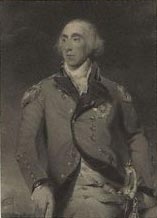
- 3rd Brigade: General Charles Grey, 1st Earl GreyCharles Grey, 1st Earl GreyCharles Grey, 1st Earl Grey, KB PC was one of the most important British generals of the 18th century. He was the fourth son of Sir Henry Grey, 1st Baronet, of Howick in Northumberland. He served in the Seven Years' War, American War of Independence and French Revolutionary War...
(3,000 in 3rd and 4th Brigades)- 15th Foot
- 17th Foot
- 42nd Foot
- 44th Foot
- 4th Brigade: Brigadier General James Agnew
- 33rd Foot
- 37th Foot
- 46th Foot
- 64th Foot
- Hessian Brigade: Colonel Carl von DonopCarl von DonopCount Carl Emilius von Donop was a Hessian colonel who fought in the American Revolutionary War.-Origins and ambitions:...
(1,300)- Linsing Grenadier Battalion
- Minningerode Grenadier Battalion
- Lengerke Grenadier Battalion
Right Wing
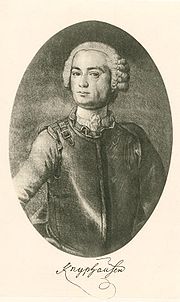
Wilhelm von Knyphausen
Wilhelm Reichsfreiherr zu Innhausen und Knyphausen was a general from Hesse-Cassel. He fought in the American Revolutionary War, during which he led Hessian mercenaries on behalf of the British Empire.-Biography:His father was colonel in a German regiment under the Duke of Marlborough...
- Unbrigaded:
- Queen's RangersQueen's RangersThe Queen's Rangers was a military unit who fought on the Loyalist side during the American War of Independence. After the war they moved to Nova Scotia and disbanded, but were reformed again in Upper Canada before disbanding again, in 1802, a decade prior to the War of 1812.-French and Indian...
, Captain James Weymss (300) - Rifle Corps, Captain Patrick FergusonPatrick FergusonMajor Patrick Ferguson was a Scottish officer in the British Army, early advocate of light infantry and designer of the Ferguson rifle. He is best known for his service in the 1780 military campaign of Charles Cornwallis, in which he aggressively recruited Loyalists and harshly treated Patriot...
(90) - 16th Light Dragoons (200)
- 71st Foot71st Regiment of Foot, Fraser's HighlandersThe 71st Regiment of Foot was a regiment of infantry raised in 1775, during the American Revolution. The unit served in both the Northern and Southern Campaigns, and participated in many major battles including the Battle of Long Island , the Battle of Brandywine , Savannah , Briar Creek , the...
(1,200)- 1st and 3rd battalions guarding the baggage train.
- 2nd battalion (350)
- Artillery: 1st and 2nd Brigades
- Six 12-pound cannons & four howitzers
- Queen's Rangers
- Hessian Brigade: Major General Johann Daniel Stirn (2,000)
- Erbprinz Infantry Regiment
- Donop Infantry Regiment
- Mirbach Infantry Regiment
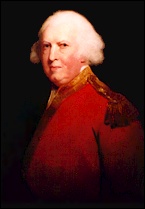
- 1st Brigade: Major General James Grant (1,400)
- 4th Foot
- 23rd Foot
- 28th Foot
- 49th Foot
- 2nd Brigade: Major General Grant (1,300)
- 5th Foot
- 10th Foot
- 27th Foot
- 40th Foot, Lieutenant Colonel Thomas Musgrave
- 55th Foot
American Army order of battle
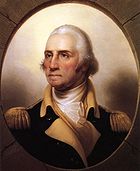
George Washington
George Washington was the dominant military and political leader of the new United States of America from 1775 to 1799. He led the American victory over Great Britain in the American Revolutionary War as commander-in-chief of the Continental Army from 1775 to 1783, and presided over the writing of...
(12,000 regulars, 3,000 militia)
Main Body
- Unattached:
- Chadds Ford redoubt: Colonel Thomas Proctor
- One 6-pound gun, two 4-pound guns, one 8-inch howitzer
- Light Infantry Corps: Brigadier General William Maxwell (1,000)
- About 100 soldiers were detached from each regular brigade to form this corps
- North Carolina Brigage: Brigadier General Francis NashFrancis NashFrancis Nash was a brigadier general killed in the American Revolutionary War.Nash was born in Prince Edward County, Virginia. At an early age he became prominent as a North Carolina merchant, attorney, and justice of the peace; experiences which eventually led to a seat in the North Carolina...
(1,094)- 1st North Carolina Regiment1st North Carolina RegimentThe 1st North Carolina Regiment was raised on September 1, 1775, at Wilmington, North Carolina, for service with the Continental Army. The regiment saw action at the Battle of Brandywine, Battle of Germantown, Battle of Monmouth and the Siege of Charleston. The regiment was captured by the British...
- 2nd North Carolina Regiment2nd North Carolina RegimentThe 2nd North Carolina Regiment was raised on September 1, 1775 at New Bern, North Carolina for service with the Continental Army. The regiment would see action at the Battle of Brandywine, Battle of Germantown, Battle of Monmouth and the Siege of Charleston. The regiment would be captured by the...
- 3rd North Carolina Regiment3rd North Carolina RegimentThe 3rd North Carolina Regiment was raised, on January 16, 1776, at Wilmington, North Carolina for service with the Continental Army. The regiment would see action at the Battle of Brandywine, Battle of Germantown, Battle of Monmouth and the Siege of Charleston. The regiment would be captured by...
- 4th North Carolina Regiment4th North Carolina RegimentThe 4th North Carolina Regiment was raised on January 16, 1776 at Wilmington, North Carolina for service with the Continental Army. The regiment saw action at the Battle of Brandywine, Battle of Germantown, Battle of Monmouth and the Siege of Charleston. The regiment was captured by the British...
- 5th North Carolina Regiment5th North Carolina RegimentThe 5th North Carolina Regiment was assigned on March 26, 1776 to the Continental Army in the Southern Department. It was organized in the spring of 1776 at Wilmington, North Carolina as eight companies of volunteers from the districts of Newbern, Edenton and Hillsborough of the colony of North...
- 6th North Carolina Regiment6th North Carolina RegimentThe 6th North Carolina Regiment was raised on March 26, 1776 at New Bern, North Carolina for service with the Continental Army. The regiment saw action at the Battle of Brandywine, Battle of Germantown and the Battle of Monmouth...
- 7th North Carolina Regiment7th North Carolina RegimentThe 7th North Carolina Regiment was raised on September 16, 1776 at Halifax, North Carolina for service with the Continental Army. The regiment saw action at the Battle of Brandywine and Battle of Germantown. The regiment was disbanded on June 1, 1778 at Valley Forge, Pennsylvania.-External links:*...
- 8th North Carolina Regiment8th North Carolina RegimentThe 8th North Carolina Regiment was raised on September 16, 1776 at Halifax, North Carolina for service with the Continental Army. They saw action at the Battle of Brandywine and Battle of Germantown. The regiment was disbanded on June 1, 1778 at Valley Forge, Pennsylvania.-External links:*...
- 9th North Carolina Regiment9th North Carolina RegimentThe 9th North Carolina Regiment was raised, on September 16, 1776, at Halifax, North Carolina for service with the Continental Army. The regiment saw action at the Battle of Brandywine and Battle of Germantown. The regiment was disbanded, on June 1, 1778, at Valley Forge, Pennsylvania.-External...
- 1st North Carolina Regiment
- Chadds Ford redoubt: Colonel Thomas Proctor
- Division: Major General John Armstrong, Sr. (2,000)
- Pennsylvania Militia Brigade: Brigadier General James PotterJames PotterJames Potter was a soldier, farmer and politician from Colonial- and Revolutionary-era Pennsylvania. He rose to the rank of brigadier general of Pennsylvania militia during the Revolutionary War, and served as Vice-President of Pennsylvania, 1781-1782.-Family and early life:James Potter was of...
- Pennsylvania Militia Brigade: Lieutenant Colonel John Lacey
- Pennsylvania Militia Brigade: Brigadier General James Potter
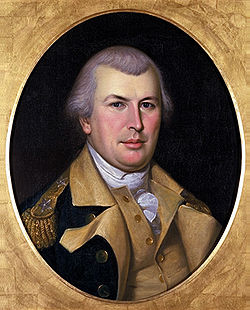
- Division: Major General Nathanael GreeneNathanael GreeneNathanael Greene was a major general of the Continental Army in the American Revolutionary War. When the war began, Greene was a militia private, the lowest rank possible; he emerged from the war with a reputation as George Washington's most gifted and dependable officer. Many places in the United...
(2,500)- 1st Virginia Brigade: Brigadier General Peter MuhlenbergPeter MuhlenbergJohn Peter Gabriel Muhlenberg was an American clergyman, Continental Army soldier during the American Revolutionary War, and political figure in the newly-independent United States...
- 1st Virginia Regiment1st Virginia RegimentThe 1st Virginia Regiment was raised, on July 17, 1775, at Williamsburg, Virginia as a state militia unit and later for service with the Continental Army. Its origins go back to the Charles City-Henrico County Regiment of Militia founded in 1652. During the French and Indian War it was the...
- 5th Virginia Regiment5th Virginia RegimentThe 5th Virginia Regiment was raised on December 28, 1775 at Richmond, Virginia for service with the U.S. Continental Army. The regiment saw action at the Battle of Trenton, Battle of Princeton, Battle of Brandywine, Battle of Germantown, Battle of Monmouth and the Siege of Charleston. The regiment...
- 9th Virginia Regiment9th Virginia RegimentThe 9th Virginia Regiment was authorized in the Virginia State Troops on January 11, 1776. It was subsequently organized between February 5 and March 16, 1776 and comprised seven companies of troops from easternmost Virginia. The unit was adopted into the Continental Army on May 31, 1776. The...
, Colonel George MathewsGeorge Mathews (Georgia)George Mathews was an United States planter, merchant, and pioneer from Virginia and western Georgia. He served in the Continental Army during the Revolutionary War then settled in Georgia. He served as the 20th Governor of Georgia, one term in the U.S... - 13th Virginia Regiment13th Virginia RegimentThe 13th Virginia Regiment was a United States infantry regiment during the American Revolutionary War.-Summary:The 13th Virginia Regiment was authorized on 16 September 1776 by the Continental Congress for service with the Continental Army during the American Revolutionary War...
- 1st Virginia Regiment
- 2nd Virginia Brigade: Brigadier General George WeedonGeorge WeedonGeorge Weedon was an American soldier during the Revolutionary War from Fredericksburg, Virginia.He served as a Brigadier General in the Continental Army and later in the Virginia militia....
- 2nd Virginia Regiment2nd Virginia RegimentThe 2d Virginia Regiment was authorized by the Virginia Convention, July 17, 1775, as a force of regular troops for the Commonwealth's defense. It consisted of seven companies, 476 privates and the usual regimental officers...
- 6th Virginia Regiment6th Virginia RegimentThe 6th Virginia Regiment was raised on December 28, 1775 at Williamsburg, Virginia for service with the Continental Army. The regiment would see action at the Battle of Trenton, Battle of Princeton, Battle of Brandywine, Battle of Germantown, Battle of Monmouth and the Siege of Charleston...
- 10th Virginia Regiment10th Virginia Regiment-History:The 10th Virginia Regiment was raised on December 28, 1775 in western Virginia for service with the Continental Army. The regiment would see action at the Battle of Brandywine, Battle of Germantown, Battle of Monmouth and the Siege of Charleston...
- 14th Virginia Regiment14th Virginia RegimentThe 14th Virginia Regiment was raised on September 16, 1776 in western Virginia for service with the Continental Army. The regiment would see action at the Battle of Brandywine, Battle of Germantown, Battle of Monmouth, and Siege of Charleston. Most of the regiment was captured at Charlestown,...
- Pennsylvania State Regiment, Colonel Walter Stewart
- 2nd Virginia Regiment
- 1st Virginia Brigade: Brigadier General Peter Muhlenberg
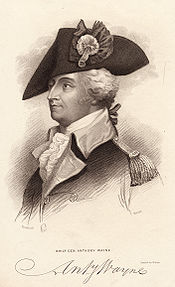
- Division: Brigadier General Anthony WayneAnthony WayneAnthony Wayne was a United States Army general and statesman. Wayne adopted a military career at the outset of the American Revolutionary War, where his military exploits and fiery personality quickly earned him a promotion to the rank of brigadier general and the sobriquet of Mad Anthony.-Early...
(2,000)- 1st Pennsylvania Brigade: Colonel Thomas HartleyThomas HartleyThomas Hartley was an American lawyer, soldier, and politician from York, Pennsylvania.He was born in Reading, Pennsylvania and practiced law in York...
- 1st Pennsylvania Regiment1st Pennsylvania RegimentThe 1st Pennsylvania Regiment, also known as the Pennsylvania Rifle Regiment and 1st Continental Regiment, was raised under the command of Colonel William Thompson for service in the Continental Army.-History:...
, Colonel James Chambers - 2nd Pennsylvania Regiment2nd Pennsylvania RegimentThe 2nd Pennsylvania Regiment, also known as The 1st Pennsylvania Battalion, was raised, October 12, 1775, under the command of Colonel John Bull for service with the Continental Army. The regiment saw action during the Battles of Brooklyn, Valcour Island, Trenton, the Brandywine, Germantown,...
, Major William Williams - 7th Pennsylvania Regiment7th Pennsylvania RegimentThe 7th Pennsylvania Regiment was raised January 4, 1776 at Carlisle, Pennsylvania for service with the Continental Army. The regiment would see action during the Battle of Brandywine, Battle of Germantown, Battle of Monmouth and the Battle of Springfield...
- 10th Pennsylvania Regiment10th Pennsylvania RegimentThe 10th Pennsylvania Regiment was raised September 16, 1776 at Philadelphia, Pennsylvania for service with the Continental Army. The regiment saw action during the Battle of Brandywine, Battle of Germantown, Battle of Monmouth and the Battle of Springfield...
, Lieutenant Colonel Adam Hubley - Hartley's Additional Continental Regiment
- 1st Pennsylvania Regiment
- 2nd Pennsylvania Brigade: Colonel Richard Humpton
- 4th Pennsylvania Regiment4th Pennsylvania RegimentThe 4th Pennsylvania Regiment was raised December 9, 1775 at Philadelphia, Pennsylvania for service with the Continental Army. The regiment would see action during the Canadian Campaign of 1775-76 , Garrison Duty at Ticonderoga 1776-77, Battle of Brandywine, Battle of Germantown, Battle of Monmouth...
- 5th Pennsylvania Regiment5th Pennsylvania RegimentThe 5th Pennsylvania Regiment was raised December 9, 1775 at Chester, Pennsylvania for service with the Continental Army. The regiment would see action during the Battle of Valcour Island, Battle of Brandywine, Battle of Germantown, Battle of Monmouth and the Battle of Springfield...
, Colonel Francis Johnston - 8th Pennsylvania Regiment8th Pennsylvania RegimentThe 8th Pennsylvania Regiment was authorized by the Continental Congress on 11 July 1776 as part of the Continental Army for frontier defense in the Northern Department during the American Revolutionary War...
- 11th Pennsylvania Regiment11th Pennsylvania Regiment-Summary:The 11th Pennsylvania Regiment was raised September 16, 1776 at Philadelphia, Pennsylvania for service with the Continental Army. The regiment would see action during the Battle of Brandywine, Battle of Germantown and the Battle of Monmouth...
- 4th Pennsylvania Regiment
- 1st Pennsylvania Brigade: Colonel Thomas Hartley
Sullivan's Wing
- Division: Major General John SullivanJohn SullivanJohn Sullivan was the third son of Irish immigrants, a United States general in the Revolutionary War, a delegate in the Continental Congress and a United States federal judge....
(1,100 less 1st Delaware & 2nd Canadian)- 1st Maryland Brigade: Unknown commander (William SmallwoodWilliam SmallwoodWilliam Smallwood was an American planter, soldier and politician from Charles County, Maryland. He served in the American Revolutionary War, rising to the rank of major general...
's brigade)- 1st Maryland Regiment1st Maryland RegimentThe 1st Maryland Regiment originated with the authorization of a Maryland Battalion of the Maryland State Troops on 14 January 1776...
- 3rd Maryland Regiment3rd Maryland Regiment-Summary:The 3rd Maryland Regiment was organized on 27 March 1776 of eight companies from Anne Arundel, Prince George's, Talbot, Harford and Somerset counties of the colony of Maryland. The regiment was authorized on 16 September 1776 for service with the Continental Army and was assigned on 27...
- 7th Maryland Regiment7th Maryland RegimentThe 7th Maryland Regiment was authorized on 16 September 1776, for service with the Continental Army and was assigned on 27 December 1776. The regiment was composed of eight companies of volunteers organized from Frederick and Baltimore counties of the colony of Maryland. On 22 May 1777, it was...
- 1st Delaware Regiment1st Delaware RegimentThe 1st Delaware Regiment was raised on December 9, 1775 for service with the continental army under the command of Colonel John Haslet. The regiment would see action during the New York Campaign, Battle of Trenton, Battle of Princeton, Battle of Brandywine, Battle of Germantown and the Battle of...
, Colonel David HallDavid Hall (Delaware governor)David Hall was an American lawyer and politician from Lewes, in Sussex County, Delaware. He was an officer in the Continental Army during the American Revolution, and member of the Democratic-Republican Party, who served as Governor of Delaware.-Early life and family:Hall was born in Lewes,...
(250)
- 1st Maryland Regiment
- 2nd Maryland Brigade: Brigadier General Chevalier Philippe Hubert Preudhomme de BorrePhilippe Hubert Preudhomme de BorrePhilippe Hubert, Chevalier de Preudhomme de Borre joined the French royal army in 1740 and served in the War of the Austrian Succession. During the American Revolutionary War he traveled to America where he was presented as a military expert. Promoted to general officer, his career as a...
- 2nd Maryland Regiment2nd Maryland RegimentFor the American Civil War regiment, see 2nd Maryland Infantry.-Summary:The 2nd Maryland Regiment origins were authorized on 14 January 1776 in the Maryland State Troops as seven independent companies.From 7 to 14 March 1776 the companies were organized from various counties from the eastern region...
- 4th Maryland Regiment4th Maryland RegimentThe 4th Maryland Regiment was organized on 27 March 1776 with eight companies from Baltimore, Anne Arundel and Somerset counties in the colony of Maryland. It was authorized on 16 September 1776 for service with the Continental Army and assigned to the main on 27 December 1776. It was assigned to...
, Colonel Josias Carvil Hall - 6th Maryland Regiment6th Maryland RegimentThe 6th Maryland Regiment was organized on 27 March 1776 composed of eight companies of volunteers from Prince Georges, Queen Anne's, Frederick, Cecil, Harford, and Anne Arundel counties in the colony of Maryland.It was authorized on 16 September 1776 for service with the Continental Army and was...
- 2nd Canadian Regiment2nd Canadian RegimentThe 2nd Canadian Regiment, also known as Congress' Own or Hazen's Regiment, was authorized on January 20, 1776, and raised in the province of Quebec for service with the Continental Army under the command of Colonel Moses Hazen. All or part of the regiment saw action at the Staten Island,...
, Colonel Moses HazenMoses HazenMoses Hazen was a Brigadier General in the Continental Army during the American Revolutionary War. Born in the Province of Massachusetts Bay, he saw action in the French and Indian War with Rogers' Rangers. His service included particularly brutal raids during the Expulsion of the Acadians and...
(400)
- 2nd Maryland Regiment
- 1st Maryland Brigade: Unknown commander (William Smallwood
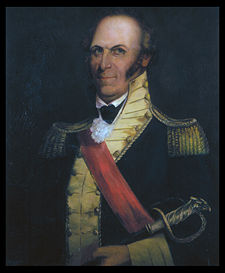
- Division: Major General Adam StephenAdam StephenAdam Stephen was a Scottish-born doctor and military officer. He came to North America, where he served in the Virginia colonial militia under George Washington during the French and Indian War. He served under Washington again in the American Revolutionary War, rising to lead a division of the...
(1,500)- 3rd Virginia Brigade: Brigadier General William WoodfordWilliam WoodfordWilliam Woodford was an American Revolutionary War general from Virginia.He was born in Caroline County, Virginia, in a town now known as Woodford. He served in the French and Indian War as an ensign in Colonel George Washington's Virginia Regiment, and was promoted to lieutenant in 1761...
- 3rd Virginia Regiment3rd Virginia RegimentThe 3rd Virginia Regiment was raised on December 28, 1775 at Alexandria, Virginia for service with the Continental Army. The 3d Virginia's initial commander was Colonel Hugh Mercer, who was quickly promoted to brigadier general. Its second commander, George Weedon, was also promoted to brigadier...
- 7th Virginia Regiment7th Virginia RegimentThe 7th Virginia Regiment was raised on January 11, 1776 at Gloucester, Virginia for service with the Continental Army. The regiment would see action at the Battle of Brandywine, Battle of Germantown , Battle of Monmouth and the Siege of Charleston...
- 11th Virginia Regiment11th Virginia RegimentThe 11th Virginia Regiment was a Continental Army regiment that fought in the American Revolutionary War.Authorized by the Second Continental Congress on 16 September 1776, it was organized on 3 February 1777 and consisted of four companies from the Virginia counties of Loudoun, Frederick, Prince...
- 15th Virginia Regiment15th Virginia RegimentThe 15th Virginia Regiment was raised on December 28, 1775 in eastern, Virginia for service with the Continental Army. The regiment would see action at the Battle of Brandywine, Battle of Germantown, Battle of Monmouth and the Siege of Charleston...
- 3rd Virginia Regiment
- 4th Virginia Brigade: Brigadier General Charles Scott
- 4th Virginia Regiment4th Virginia RegimentThe 4th Virginia Regiment was raised on December 28, 1775 at Suffolk Court House, Virginia for service with the Continental Army. The regiment saw action at the Battle of Trenton, Battle of Princeton, Battle of Brandywine, Battle of Germantown, Battle of Monmouth and the Siege of Charleston...
- 8th Virginia Regiment8th Virginia RegimentThe 8th Virginia Regiment was raised on January 11, 1776 at Suffolk Court House, Virginia for service with the Continental Army under the command of Peter Muhlenberg. The regiment would see action at the Battle of Brandywine, the Battle of Germantown and the Battle of Monmouth...
- 12th Virginia Regiment12th Virginia RegimentThe 12th Virginia Regiment was raised on September 16, 1776 at Williamsburg, Virginia for service with the Continental Army. The regiment saw action in the Battle of Brandywine, Battle of Germantown, Battle of Monmouth and the Siege of Charleston...
- 4th Virginia Regiment
- 3rd Virginia Brigade: Brigadier General William Woodford
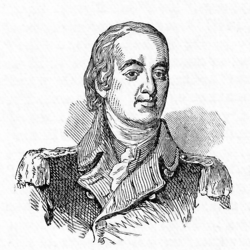
- Division: Major General William Alexander, Lord Stirling (1,500)
- New Jersey Brigade: Brigadier General William MaxwellMaxwell led the Light Infantry Corps and the sources did not list who led the New Jersey Brigade.
- 1st New Jersey Regiment1st New Jersey RegimentThe 1st New Jersey Regiment was the first organized militia regiment in New Jersey, formed in 1673 in Piscataway "to repel foreign Indians who come down from upper Pennsylvania and western New York to our shores and fill with fishes and clams and on the way back make a general nuisance of...
, Colonel Matthias OgdenMatthias OgdenMatthias Ogden was born at Elizabeth, New Jersey on October 22, 1754, Fought in the American revolutionary war and served various political positions afterwards.-Family:... - 2nd New Jersey Regiment2nd New Jersey RegimentThe 2nd New Jersey Regiment was raised, on 9 October 1775, at Trenton, New Jersey, for service with the Continental Army under the command of Colonel William Maxwell...
- 3rd New Jersey Regiment3rd New Jersey RegimentThe 3rd New Jersey Regiment was raised, on January 1, 1776, at Elizabethtown, New Jersey for service with the Continental Army. One of the captains of this regiment was Jonathan Dayton, the youngest signer of the Constitution...
, Colonel Elias DaytonElias DaytonElias Dayton was the Mayor of Elizabethtown, New Jersey-Biography:He was born in Elizabeth, Union County, New Jersey.... - 4th New Jersey Regiment4th New Jersey RegimentThe 4th New Jersey Regiment from the revolution as followed by the 4th NJ in the Civil War.The originalwas raised on September 16, 1776 at Elizabethtown, New Jersey for service with the Continental Army. The regiment would see action at the Battle of Brandywine, Battle of Germantown and the Battle...
- 1st New Jersey Regiment
- 3rd Pennsylvania Brigade: Brigadier General Thomas ConwayThomas ConwayThomas Conway was a French soldier from Ireland who served as a major general in the American Continental Army during the American Revolutionary War. He became involved with the alleged Conway Cabal. He later served with Émigré forces during the French Revolutionary War.-Early life:Conway was born...
- 3rd Pennsylvania Regiment3rd Pennsylvania RegimentThe 3rd Pennsylvania Regiment was raised, on December 9, 1775, at Philadelphia, Pennsylvania for service with the Continental Army. The regiment would see action during the Battle of Valcour Island, Battle of Brandywine, Battle of Germantown, Battle of Monmouth and the Battle of Springfield...
- 6th Pennsylvania Regiment6th Pennsylvania RegimentThe 6th Pennsylvania Regiment was a unit of the United States of America Army, raised December 9, 1775 at Philadelphia, Pennsylvania for service with the Continental Army. The regiment would see action during the New York Campaign, Battle of Brandywine, Battle of Germantown, Battle of Monmouth and...
- 9th Pennsylvania Regiment9th Pennsylvania RegimentThe 9th Pennsylvania Regiment was authorized 16 September 1776 and was assigned to the main Continental Army on 27 December 1776. It was organized during the spring of 1777 to consite of eight companies of volunteers from Westmoreland, Lancaster, Chester, Philadelphia and Cumberland counties of the...
- 12th Pennsylvania Regiment12th Pennsylvania RegimentThe 12th Pennsylvania Regiment also known as Northumberland Defense Battalion was raised August 23, 1776 at Sunbury, Pennsylvania as a state militia regiment and later for service with the Continental Army. The regiment would see action during the Battle of Brandywine, Battle of Germantown and the...
- 3rd Pennsylvania Regiment
- New Jersey Brigade: Brigadier General William MaxwellMaxwell led the Light Infantry Corps and the sources did not list who led the New Jersey Brigade.

